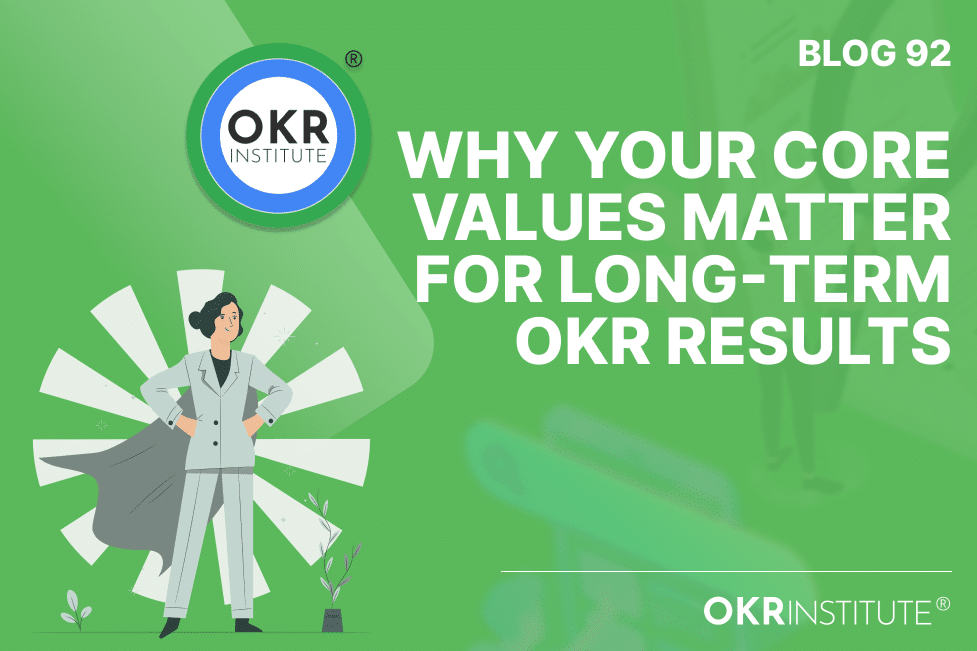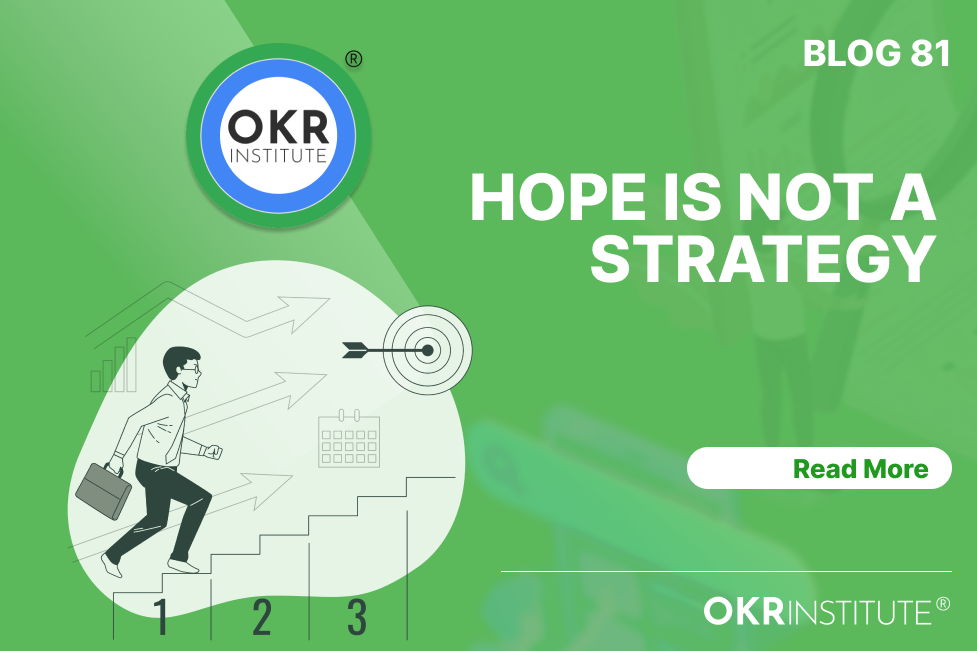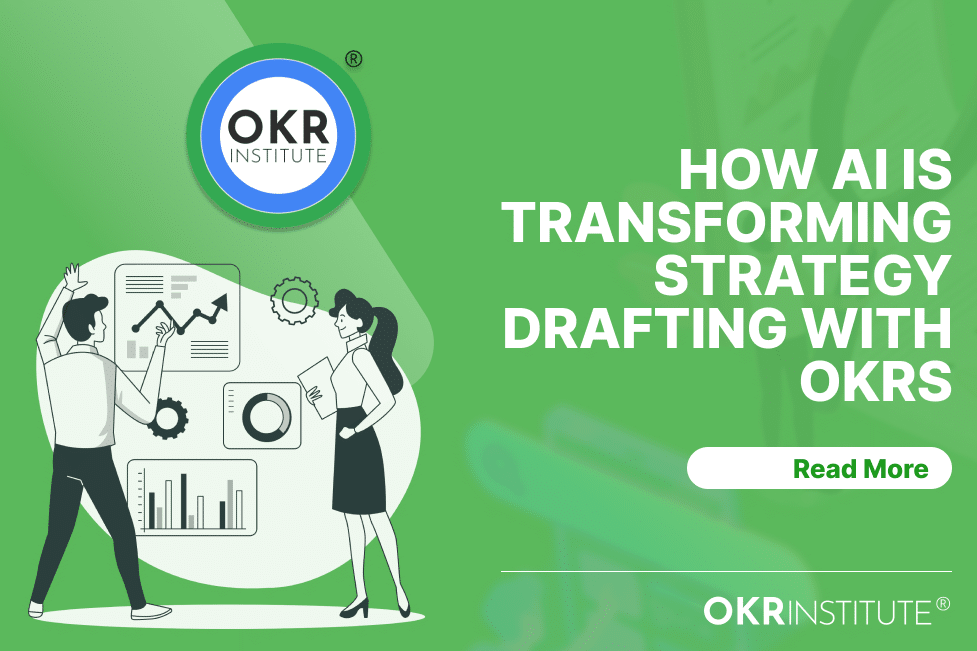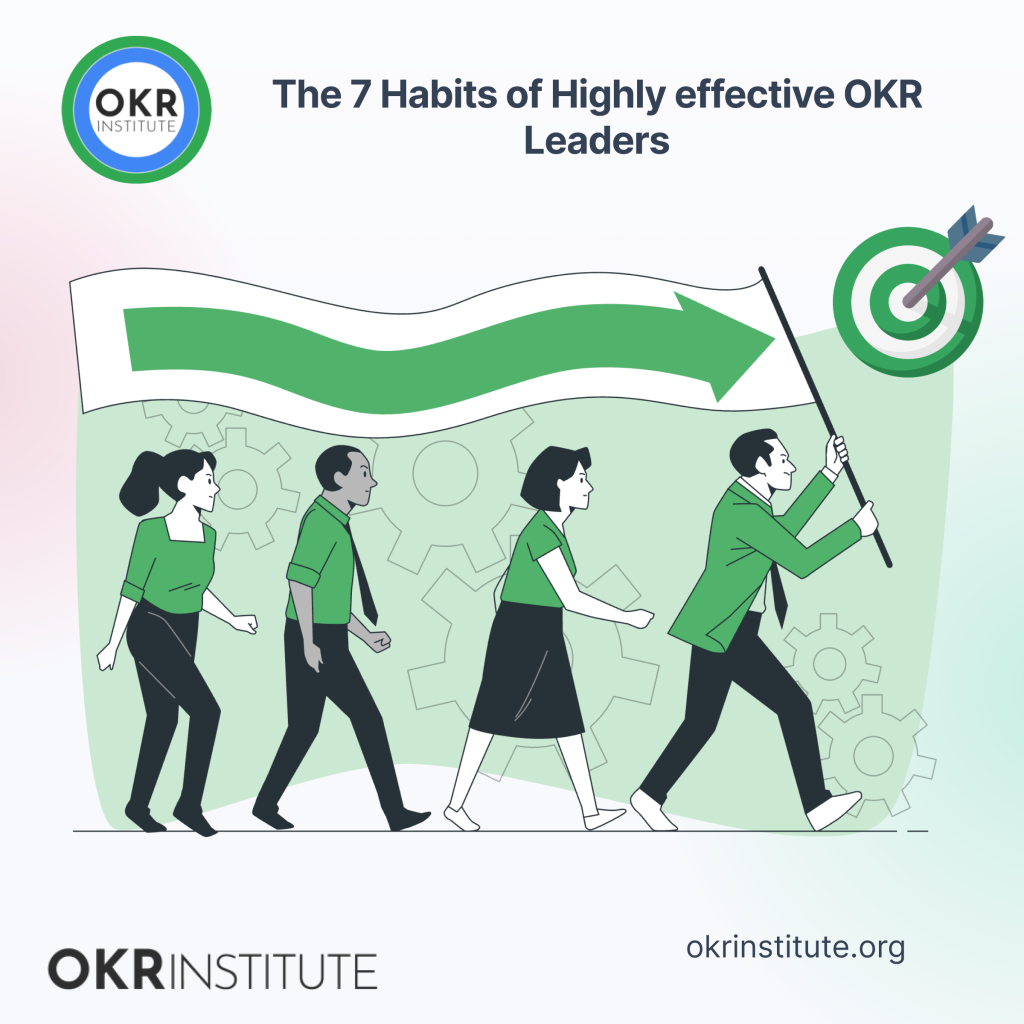Why Your Core Values Matter for Long-Term OKR Results

Introduction to Company Core Values and OKRs
Company core values are the fundamental beliefs and guiding principles that shape an organization’s culture, decision-making processes, and overall behavior. These values serve as a moral compass, defining what the company stands for and how it conducts its operations. They are the foundation upon which the company’s mission, vision, and strategies are built.
On the other hand, Objectives and Key Results (OKRs) are a goal-setting and performance management framework that helps organizations translate their strategic objectives into measurable and achievable goals. OKRs provide a structured approach to setting, tracking, and achieving objectives by defining clear, time-bound targets and the key results that indicate progress towards those objectives.
The successful implementation of OKRs within an organization is heavily influenced by the alignment between the company’s core values and the OKR framework. When core values and OKRs are in sync, they create a powerful synergy that drives organizational success and fosters a culture of accountability, transparency, and continuous improvement.
By embedding core values into the OKR process, companies can ensure that their goals and objectives are not only ambitious but also aligned with their fundamental beliefs and principles. This alignment helps to maintain a consistent direction and ensures that the organization’s actions and decisions are guided by its core values, even as it navigates through challenges and changes.
Aligning Core Values with OKRs
Aligning core values with Objectives and Key Results (OKRs) is crucial for ensuring a successful and sustainable implementation. Core values represent the fundamental beliefs and principles that guide an organization’s actions and decision-making processes. By integrating these values into OKRs, companies can establish a strong foundation for goal-setting and achievement that resonates with their culture and identity.
One effective approach is to use core values as a lens through which OKRs are developed and evaluated. For example, if one of an organization’s core values is “customer-centricity,” its OKRs should reflect a commitment to enhancing customer experience, satisfaction, and loyalty. This could translate into objectives such as “Improve customer satisfaction ratings” or “Increase customer retention rate,” with corresponding key results that measure progress towards these goals.
Another example could be a company that values “innovation.” In this case, OKRs might focus on developing new products, services, or processes that disrupt the market or solve pressing customer problems. Key results could track the number of new ideas generated, patents filed, or successful product launches.
By aligning OKRs with core values, organizations can ensure that their goals are not only ambitious and measurable but also deeply rooted in their fundamental principles. This alignment helps to maintain consistency and integrity across all levels of the organization, fostering a sense of purpose and direction that transcends individual objectives.
Embedding Core Values in OKR Implementation
Integrating core values into the OKR framework is crucial for achieving sustainable success. By aligning OKRs with the organization’s guiding principles, you create a cohesive and purpose-driven approach that resonates with employees and stakeholders alike. Here are some strategies to embed core values in your OKR implementation:
Define Value-Driven OKRs: When setting OKRs, ensure that they reflect and uphold your core values. For example, if one of your values is “customer-centricity,” your OKRs should prioritize initiatives that enhance customer experience and satisfaction.
Align Key Results with Core Values: Craft Key Results that not only measure progress towards Objectives but also reinforce your core values. This could involve metrics related to employee engagement, environmental sustainability, or ethical business practices.
Incorporate Values in OKR Descriptions: When documenting OKRs, explicitly reference the core values they support. This helps employees understand the “why” behind each OKR and fosters a deeper connection with the organization’s purpose.
Integrate Values in Progress Tracking: During OKR check-ins and reviews, assess not only the quantitative progress but also the qualitative alignment with core values. Celebrate wins that uphold your values and address any deviations promptly.
Leverage OKR Conversations: Use OKR discussions as opportunities to reinforce core values. Share success stories and examples of how individuals or teams embodied the values through their work, inspiring others to follow suit.
Provide Value-Aligned Coaching: When coaching employees on OKRs, tie feedback and guidance to core values. Help them understand how their efforts contribute to the organization’s broader purpose and cultural fabric.
Recognize and Reward Value-Driven Behaviors: Implement recognition and reward systems that celebrate individuals or teams who exemplify core values through their OKR achievements. This reinforces the desired behaviors and creates a positive feedback loop.
By embedding core values throughout the OKR lifecycle, you foster a culture of purpose, accountability, and alignment. Employees understand that their work is not just about hitting targets but also about upholding the organization’s guiding principles, leading to a more engaged, motivated, and values-driven workforce.
The Role of Leadership
Leadership plays a pivotal role in ensuring the successful integration of core values into the OKR implementation process. Commitment from the top is essential for embedding these guiding principles into the organization’s DNA and driving the desired cultural transformation.
Effective leaders must lead by example, embodying the core values in their day-to-day actions and decision-making. By modeling value-driven behavior, they set the tone for the entire organization and inspire others to follow suit. This consistency between words and actions fosters trust and credibility, making it easier for employees to embrace the core values and align their goals accordingly.
Moreover, leadership is responsible for cascading OKRs throughout the organization, ensuring that individual and team objectives are aligned with the company’s overarching goals and core values. This top-down approach ensures a cohesive and unified direction, where every employee understands how their contributions fit into the bigger picture and support the organization’s values and mission.
Leaders must also create an environment that encourages open communication and feedback, allowing employees to voice their concerns, share ideas, and actively participate in the OKR process. By fostering a culture of transparency and collaboration, leaders can identify potential misalignments between core values and OKRs, and make necessary adjustments to maintain consistency and authenticity.
Engaging Employees with Core Values and OKRs
Engaging employees is crucial for successful OKR implementation aligned with core values. Here are some effective methods:
Open Communication and Transparency: Foster an environment of open communication where employees can provide input, ask questions, and voice concerns. Transparency about the company’s goals, values, and OKR progress builds trust and buy-in.
Training and Education: Provide comprehensive training to help employees understand the company’s core values, the OKR framework, and how they interconnect. Ensure they grasp the rationale behind OKRs and their role in achieving company objectives.
Cross-Functional Collaboration: Encourage cross-functional collaboration during OKR setting and review processes. This promotes alignment, shared understanding, and a sense of collective ownership.
Employee Feedback and Involvement: Actively seek employee feedback and involve them in defining OKRs and identifying ways to embed core values. This fosters a sense of ownership and commitment.
Recognition and Rewards: Recognize and reward employees who exemplify core values and contribute to achieving OKRs. This reinforces desired behaviors and motivates others to follow suit.
Storytelling and Success Sharing: Share success stories and examples of how employees have lived the core values and achieved remarkable results through OKRs. This inspires others and reinforces the connection between values and performance.
Lead by Example: Leaders must embody the core values and demonstrate their commitment to OKRs through their actions and decision-making. This sets the tone and encourages employees to follow suit.
By actively engaging employees in the OKR process and aligning it with core values, organizations can foster a culture of shared purpose, accountability, and continuous improvement.
Measuring and Reinforcing Core Values
Embedding core values into the fabric of an organization requires more than just lip service – it demands a systematic approach to measurement and reinforcement. This is where OKRs (Objectives and Key Results) can play a pivotal role, serving as a powerful tool to track and reinforce the manifestation of core values in tangible, measurable ways.
At the heart of this approach lies the practice of crafting OKRs that are explicitly aligned with the organization’s core values. For instance, if one of the core values is “customer-centricity,” an OKR could be set to improve customer satisfaction scores by a specific percentage within a given timeframe. By tying OKRs directly to core values, organizations can ensure that their operational goals and day-to-day activities are guided by the principles that define their culture and identity.
Moreover, OKRs provide a structured framework for tracking progress and celebrating successes. Regular check-ins and progress updates not only hold teams accountable but also serve as opportunities to recognize and reward individuals or teams who have exemplified the core values through their actions and achievements. This recognition can take various forms, such as public acknowledgment, incentives, or even incorporating value-driven achievements into performance evaluations.
Reinforcing core values through OKRs also fosters a culture of transparency and open communication. By openly discussing progress, challenges, and successes related to value-driven OKRs, organizations can foster a sense of shared ownership and collective responsibility towards upholding their core values. This transparency can also help identify areas where additional support, resources, or training may be needed to better align behaviors with the desired values.
Furthermore, the data gathered through OKR tracking can provide valuable insights into the effectiveness of the organization’s core value implementation. By analyzing trends and patterns, leaders can identify areas where values are being consistently upheld or where there may be gaps or inconsistencies. This information can then inform strategic decisions, policy changes, or targeted initiatives to further strengthen the organization’s commitment to its core values.
Overcoming Challenges
Aligning core values with OKRs is not without its challenges. One common pitfall is a disconnect between the stated values and the actual behaviors and priorities within the organization. If employees perceive a misalignment between the company’s espoused values and its actions, it can breed cynicism and undermine the effectiveness of the OKR process.
Another challenge is the tendency for core values to become mere lip service, with little tangible impact on decision-making and day-to-day operations. To avoid this, organizations must actively integrate their values into the OKR process, using them to guide goal-setting, prioritization, and resource allocation.
Strategies for addressing misalignment include:
- Transparent Communication: Foster open dialogue and feedback loops to identify and address any perceived gaps between values and actions. Encourage employees to voice their concerns and provide constructive criticism.
- Accountability Measures: Establish clear metrics and accountability mechanisms to ensure that core values are consistently upheld across all levels of the organization. This could involve incorporating value-based metrics into performance evaluations or tying compensation to the demonstration of core values.
- Continuous Reinforcement: Regularly reinforce the importance of core values through training, recognition programs, and leadership messaging. Celebrate and showcase examples of individuals and teams exemplifying the company’s values in their work and OKR achievements.
- Adaptability and Evolution: Recognize that core values may need to evolve over time to remain relevant and aligned with the organization’s growth and changing circumstances. Periodically review and refine the core values to ensure they continue to resonate with employees and guide the company’s strategic direction.
By proactively addressing these challenges and fostering a culture of alignment and accountability, organizations can successfully integrate their core values into the OKR process, driving sustainable success and fostering a values-driven workplace.
Case Studies
Google is renowned for its strong corporate culture and values like “Don’t be evil,” innovation, and a focus on the user. These core values have been deeply integrated into their OKR program. For example, Google’s OKRs emphasize launching innovative products that provide an excellent user experience, aligning with their values. Their OKRs also incorporate ethical considerations, ensuring new products and features adhere to their “Don’t be evil” principle.
Patagonia
Outdoor clothing company Patagonia has a core value of environmental sustainability at the heart of its operations. Their OKRs reflect this commitment, with objectives focused on reducing their carbon footprint, using sustainable materials, and advocating for environmental causes. Patagonia’s OKRs have driven initiatives like using recycled materials in their products, investing in renewable energy sources for their facilities, and campaigning for environmental protection legislation.
Salesforce
Salesforce is a company that prides itself on its values of trust, customer success, innovation, and equality. These values are deeply ingrained in their OKR program. For instance, their OKRs include objectives related to maintaining the highest levels of data security and privacy to foster trust with customers. Additionally, they have OKRs centered on promoting diversity, equity, and inclusion within the company and in their community outreach efforts.
Adapting to Change
As organizations grow and evolve, their core values and objectives may need to be revisited and adjusted to align with changing circumstances. Maintaining a successful OKR implementation requires a willingness to adapt and evolve both the core values and the OKRs themselves.
Revisiting and evolving core values is a critical step in ensuring that they remain relevant and aligned with the organization’s current mission, vision, and goals. Core values should be living principles that guide decision-making and behavior, rather than static statements that become outdated or disconnected from the organization’s reality.
When core values are revised, it’s essential to communicate the changes clearly and consistently throughout the organization. Employees need to understand the rationale behind the changes and how they will impact the organization’s culture and priorities. Engaging employees in the process of revisiting and refining core values can foster a sense of ownership and commitment to the updated principles.
Maintaining OKR alignment during organizational changes is equally important. As the organization’s strategy, structure, or operating environment evolves, the OKRs may need to be adjusted to ensure they remain relevant and achievable. This process should involve input from stakeholders across the organization, including leaders, managers, and front-line employees.
During periods of change, it’s crucial to reinforce the connection between the organization’s core values and its OKRs. Leaders should communicate how the updated core values and OKRs align and how they will guide the organization’s actions and decision-making moving forward.
Adapting to change also requires a willingness to learn and iterate. Organizations should continuously monitor the effectiveness of their OKR implementation and make adjustments as needed. Gathering feedback from employees, analyzing performance data, and staying attuned to external factors can help identify areas for improvement and ensure that the OKR process remains effective and aligned with the organization’s evolving core values.
Conclusion
Aligning company core values with the implementation of Objectives and Key Results (OKRs) is crucial for achieving long-term, sustainable success within an organization. By embedding core values into the OKR framework, companies can foster a culture of accountability, transparency, and continuous improvement.
The key takeaways from this exploration are:
- Clear Purpose and Direction: Core values provide a guiding light for the organization, ensuring that OKRs are set in alignment with the company’s fundamental beliefs and principles. This alignment helps maintain focus and ensures that efforts are directed towards achieving meaningful goals.
- Employee Engagement and Motivation: When employees understand and connect with the organization’s core values, they are more likely to embrace and actively participate in the OKR process. This engagement leads to increased motivation, ownership, and a shared sense of purpose.
- Consistent Decision-Making: Core values serve as a reference point for making decisions at all levels of the organization. By aligning OKRs with core values, companies can ensure that decisions are consistent and support the overall strategic direction.
- Continuous Improvement and Adaptation: Regularly revisiting and reinforcing core values during the OKR cycle fosters a culture of continuous learning and adaptation. This flexibility allows organizations to pivot and adjust their strategies as needed, while remaining true to their core principles.
- Organizational Resilience: Companies that successfully integrate core values into their OKR implementation demonstrate greater resilience in the face of challenges and market disruptions. A strong value-driven foundation provides stability and a sense of purpose, enabling organizations to navigate through turbulent times.
In conclusion, embracing core values as the foundation for OKR implementation is not just a best practice; it is a strategic imperative for organizations seeking long-term, sustainable success. By aligning their goals, strategies, and actions with their core values, companies can build a culture of accountability, engagement, and continuous improvement, ultimately driving better results and fostering a competitive advantage.
CEO of the OKR Institute
Related Courses
Recent Posts
Tags
#OKR
#OKR Implementation
#Core Values







